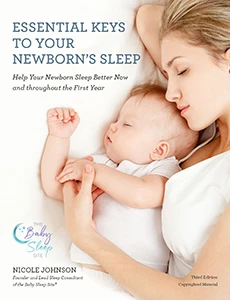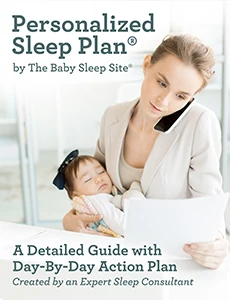
When you bring your brand new baby home, no one tells you that “sleep like a baby” may not happen, or that if it does, it may only last a short time. This article will give you 10 great tips to help your newborn sleep better.
Before I get to the 10 tips to help your newborn sleep, I thought I should note that it can be dangerous for a newborn baby to sleep all night. They need to eat at least every 2-3 hours in the early days so they can grow well and thrive.
Additionally, it is only recommended to place baby on their back to sleep, to guard against SIDS. You may be interested in other ways to lower SIDS risks here too.
There, now that I got that out of the way…
Newborn Baby Sleep
1. Short Wake-time
The first week or so, your newborn baby will most likely hardly be awake, but after the first week or two, the #1 key with your newborn is to keep wake times very short, at first. You should soothe your baby for sleep after just 1-2 hours of wake time TOPS. You should look for signs that she is getting sleepy and start soothing her. If you wait until she is fussy, cranky or crying, you are actually too late!
An overtired baby will have more trouble settling down and going to sleep and staying asleep. My boys always fell asleep easiest when I caught them before they started to fuss and cry. Some babies are much more sensitive to being overtired than others, so while others will barely notice their child get sleepy before she drifts off to sleep, others will begin to realize just how in tune with their baby they need to be!
By wake time, I mean to include feedings and diaper changes and disregard how long her last nap was. For example, little Suzie starts to nap at 8am and sleeps for 3 hours. She eats at 11am and you change her diaper. Now, it’s 11:30 and you decide to give her a bath. At 11:45, she is fussy. She is already overtired and she needs a nap! In the beginning, they can’t go long before getting tired and overstimulated.
2. Swaddle
To help mimic the feeling of the womb, it helps to swaddle your newborn baby. This basically means to wrap him up in a blanket like a little burrito. You may have seen them do it at the hospital. This helps him feel safe and secure and also helps him stay asleep during any moro reflex or startle reflex moments. It is said that those reflexes are similar to how we have the feeling we are falling while falling asleep. It can take up to 4 or 5 months for your baby to stop the startling.
I recommend The Miracle Blanket for swaddling. It is so easy to use and so hard for your baby to break out of!
I’d also like to share our article about swaddling for naps, and I encourage you to read these tips for safe swaddling too.
3. Keep Days Bright and Nights dark
Although you might be tempted to keep things quiet and darker for your newborn to nap well, it might prolong the day/night confusion that almost all newborns will have. Day/Night confusion can last up to 6 weeks. When she was in mom’s belly, mom’s movements lulled her to sleep and when mom was resting, she’d have a party. When she comes out, she doesn’t know she should act in the complete opposite fashion.
So, keep days bright and upbeat and nights, dark and boring, and it will help your newborn sort out her days and nights faster. This might be more than you want to know, but light is what cues our eyes to tell us to stay awake or whether it’s time to sleep.
4. Limit Naps
If he is taking longer to sort out days and nights (or you are having a very rough time keeping up with him being up all night), you can further speed up the process by limiting naps to no longer than 3-4 hours during the day. Read more here about newborn sleep patterns and schedules.
5. Post-feeding Routine
To help your newborn baby sort out day and night sleeping even more, you may want to develop a play routine after she eats during the day. Keep her awake 30 minutes after feeding by playing, singing, bathing, etc. Again, the light stimulating her eyes will help her sort out that daylight is for being awake at least a little bit. Many people recommend the eat-play-sleep routine for newborns. This is the primary message of the popular book, On Becoming Baby Wise. You might want to read why Babywise may not be right for your baby, though.
6. Co-Sleeping
Sometimes, it helps to have your newborn in the room with you for quick access to middle-of-the-night feedings and diaper changes. In fact, the AAP recommends sharing a room with your baby for the first 6-12 months! This is safer but also, it can help give them more comfort being close by the baby will be able to hear and smell you. For safety reasons, you should use a Co-Sleeper or bassinet, rather than have baby in bed with you.
This article includes some tips for safe bed-sharing. You can also read more about the differences between co-sleeping and bed-sharing.
7. Angle the mattress
For babies who spit up a lot or have reflux, it helps to angle the mattress when they sleep, so baby is not flat on their back. You’ll want to angle the mattress so their feet are lower than their head and so their stomach contents can stay put.
To angle the mattress, you can simply change the support platform level on one side of most cribs. If that is not feasible, you can put blankets and a pillow under the mattress. Please note that the mattress should still remain flat at all times, just at a slight incline. You must make sure that you do NOT tilt the mattress so much that your baby slides down the bed, either.
I strongly recommend that you first check with a knowledgeable healthcare provider to make sure that what you do is best and safest for your child. I only wanted to highlight the idea.
8. White Noise
White noise is made up of the sounds like a fan whirring, vacuum cleaner, hair-dryer, etc. It helps a newborn sleep because inside mom’s womb was all white noise. The sound of her blood flow, heart beating, etc. That’s why he finds comfort when you may run the vacuum cleaner. My son used to love when I turned on the blow-dryer. Of course, you can’t run the vacuum all day, so I recommend getting a White Noise machine or MP3. You can also read more about How White Noise Can Help Your Baby Sleep here. And here, you can read further about some smartphone White Noise apps that may help your baby sleep.
9. Wear Baby
For particularly fussy babies or just for parent’s convenience and snuggling, it helps to “wear” baby using a sling. They get very folded up in a sling, but again, it mimics the womb and babies love it!
I didn’t use a sling with my first, but used a BabyBjorn Baby Carrier and we both loved it! It also really helped me walk off the baby weight, which was a bonus. But, with my second, I did use a sling. My son would fall asleep in less than 5 minutes until he grew out of it. This helped tremendously when I needed to cook dinner and do stuff with my toddler at the time. I have also heard good things about the Moby Wrap, Boba Baby Wrap, and the Ergobaby Wrap from clients all over the world!
10. Swing
I also recommend trying a swing. Don’t be surprised if your newborn only likes it at higher speeds. Our family teased us we were making our first son “drunk.” He just loved his swing going FAST likely because he was spirited. It was the only way he’d fall asleep in it! We used a simple swing like this to help him sleep. I had my babies many years ago now, but they have much fancier swings, now, such as the swings with cry detection technology which are highly rated. They didn’t have anything like that when I was shopping for a swing. Technology is ah-mazing!
Unfortunately, some of these tips do create sleep associations, which we know can be problematic. However, during the first weeks, you really do what you can to survive and focus on bonding with your newborn. Obviously, it never hurts to try to put your baby down to sleep without any of these “tricks,” but as I’ve probably said a billion times already on this site, it just doesn’t work for all of us.







